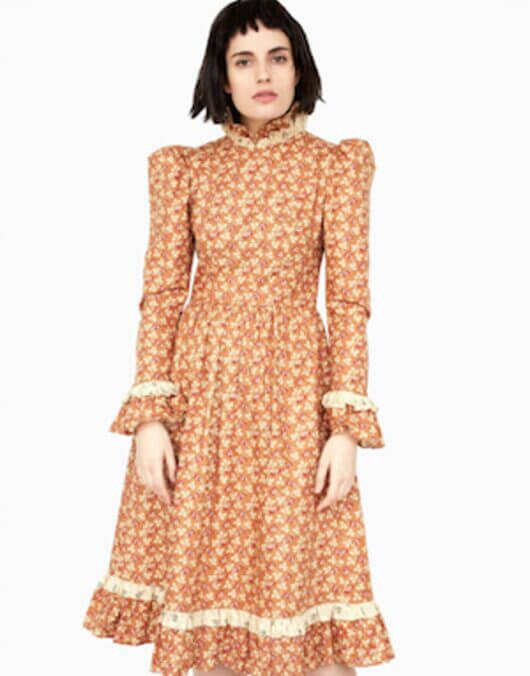
Image: Angelica Alzona/GMG
Laura Ingalls Wilder’s classic novels, based on her childhood in the late 1860s and 1870s in Minnesota’s Big Woods and on land belonging to the Osage nation in Kansas, are full of admiring descriptions of femininity on the American frontier: dresses, braids, pies, and babies. Laura’s beloved Ma, Wilder writes in a mind-bending aside, was so disciplined about wearing a corset in her youth that Pa could encircle her entire waist with his hands when they got married. Ma is a model frontier wife and mother: she coaxes delicious pie out of an unripe pumpkin, mends dresses, lets out hems when there is no money for fabric, and fashions new dresses out of flowered calico cotton when there is. She drives a team of horses and their covered wagon across a creek in a flash flood, saves their worldly possessions from a prairie fire, and works alongside Pa to build their log cabin.
This appealing myth of the frontier woman, at once capable, even fierce, and feminine, perhaps explains the resurgence of the “prairie dress,” 2018’s most improbable urban fashion trend. Prairie dresses, from high-end designers like Doên, Christy Dawn, and Batsheva Hay, are exactly what they sound like—shapeless, high necked and long-hemmed, made from brown or intricately flowered rough-woven cotton or linen, and marketed with imagery that makes explicit references to the American West. They are a style associated either with the postbellum frontier or with the “modest” dressing styles of some fundamentalist Christian women, like Mennonites, Mormons, or the Amish. (Hay has also cited Orthodox Judaism as an inspiration.)
Yet they’ve become so ubiquitous that the New York Times Styles section named modest dressing the defining style of the 2010s. The dresses have appeared on a particular set of urbanites, women who blend progressive politics with 21st century forms of homemaking like minimalist lifestyle blogging, sprouting grains in their kitchens, baby wearing, and living in apartments small enough to evoke the house Pa built on the Kansas prairie, where the number of children they conceive has an inverse relationship to the privacy their bedrooms appear to afford.

“There is something about the idea of a frontier woman that’s so interesting to me, because it’s so tough and adventurous,” Hay, one of the original purveyors of the prairie dress, told The Daily Beast in October. “I love mixing that strength with styles that are covered-up, dainty, and restrained.”
The dresses evoke a certain nostalgia, a throwback to a time when femininity and women’s identity was sharply defined and didn’t have to be individually conjured or chosen. One was a homemaker, in the literal sense of making a home from scratch, and a wife, mother, and defender of the family. There’s a comforting familiarity to it. Lena Dunham told the New Yorker, “They really look like […] the dresses that characters in your favorite book would have worn.”
It’s a pleasant thought. But in Dunham’s likely “favorite book,” Ma is also startlingly, overtly racist, in ways that are inextricable from her brand of frontier femininity. “Why don’t you like Indians?” Laura asks her over corn cakes and molasses on the steps of their covered wagon, which Ma had laid out like a table, complete with a centerpiece of flowers in a tin can. “I just don’t like them,” Ma replies. “And don’t lick your fingers, Laura.”
Anyway, Ma assures her, “the Indians would not be here long.” The government would soon push the Native people west, she explained, once white settlers arrived. In moments like this, Ma is as active in developing her daughters’ racism and sense of ownership over the land—land that we now know the Ingalls family had no legal, let alone historical, right to claim—as she is in shaping their notions of how women should act, work, and dress.

This is no contradiction. Clothing is a civilizing force in Ma’s mind, one that serves to separate her children from the Native people they encounter. The bonnets she makes her girls wear are intended to protect their skin from darkening in the prairie sun. “I declare,” Ma says, “if you girls aren’t getting to look like Indians! Can I never teach you to keep your sunbonnets on?” When she interacts with Native people, Ma is first and foremost horrified at the perceived inappropriateness of their dress. “They wore fresh skunk skins,” she tells Pa, “and that’s all they wore.” One evening, as she prepares dinner in her newly-built house on land the Osage retained in a Reconstruction-era treaty with the federal government, Ma complains without irony, “Indians are getting so thick around here that I can’t look up without seeing one.”
-

-

-

-

-

-

-

-

-

-

-

-

-

-

-

-

-

-

-

-

-

-

-

-

-

-

-

-

-

-

-

-

-

-

-

-

-

-

-

-









































